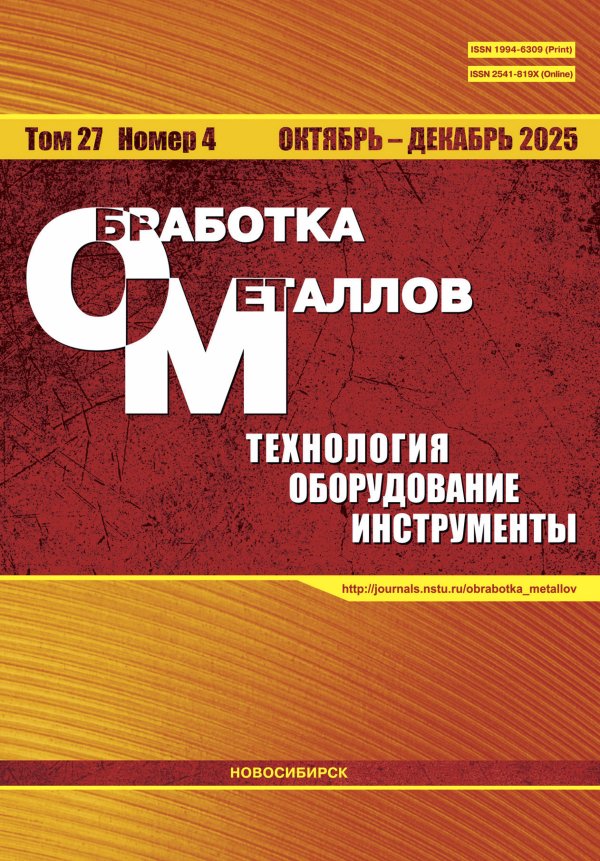Влияние диффузионного титанирования из среды легкоплавких жидкометаллических растворов на работоспособность режущего твердосплавного инструмента типа ТК и ВК
- Авторы: Соколов А.Г.1, Бобылёв Э.Э.1
-
Учреждения:
- Выпуск: Том 20, № 4 (2018)
- Страницы: 46-59
- Раздел: ОБОРУДОВАНИЕ. ИНСТРУМЕНТЫ
- URL: https://journal-vniispk.ru/1994-6309/article/view/302088
- DOI: https://doi.org/10.17212/1994-6309-2018-20.4-46-59
- ID: 302088
Цитировать
Полный текст
Аннотация
Об авторах
А. Г. Соколов
Email: sag-51@bk.ru
доктор технических наук, профессор, Кубанский государственный технологический университет, sag-51@bk.ru
Э. Э. Бобылёв
Email: ebobylev@mail.ru
аспирант, Кубанский государственный технологический университет, ebobylev@mail.ru
Список литературы
- Соколов А.Г., Бобылёв Э.Э. Элементно-фазовый состав и свойства диффузионных титановых покрытий на режущем твердосплавном инструменте типа ТК и ВК // Письма о материалах. – 2017. – Т. 7, № 3. – С. 222–228. – doi: 10.22226/2410-3535-2017-3-222-228.
- Effect of titanium carbide coating on the osseointegration response in vitro and in vivo / M. Brama, N. Rhodes, J. Hunt, A. Ricci, R. Teghil, S. Migliaccio, C. Della Rocca, S. Leccisotti, A. Lioi, M. Scandurra, G. De Maria, D. Ferro, F. Pu, G. Panzini, L. Politi, R. Scandurra // Biomaterails. – 2007. – Vol. 28, iss. 4. – P. 595–608. – doi: 10.1016/j.biomaterials.2006.08.018.
- On the effect of the substrate to target position on the properties of titanium carbide/carbon coatings / J. Daniel, P. Soucek, L. Zábranský, V. Buršíková, M. Stupavská, P. Vašina // Surface And Coatings Technology. – 2017. – Vol. 328. – P. 462–468. – doi: 10.1060/j.surfcoat.2017.06.076.
- Formation of titanium carbide (TiC) and TiC@C core-shell nanostructures by ultra-short laser ablation of titanium carbide and metallic titanium in liquid / A. De Bonis, A. Santagata, A. Galasso, A. Laurita, R. Teghil // Journal of Colloid and Interface Science. – 2017. – Vol. 489. – P. 76–84. – doi: 10.1016/j.jcis.2016.08.078.
- Titanium carbide coating with enhanced tribological properties obtained by EDC using partially sintered titanium electrodes and graphite powder mixed dielectric / Z.J. Xie, Y.J. Mai, W.Q. Lian, S.L. He, X.H. Jie // Surface and Coatings Technology. – 2016. – Vol. 300. – P. 50–57. – doi: 10.1016/j.surfcoat.2016.04.080.
- Understanding the diffusion wear mechanisms of WC-10%Co carbide tools during dry machining of titanium alloys / C. Ramirez, A. Idhil Ismail, C. Gendarme, M. Dehmas, E. Aeby-Gautier, G. Poulachon, F. Rossi // Wear. – 2017. – Vol. 390–391. – P. 61–70. – doi: 10.1016/j.wear.2017.07.003.
- Ильин А.А., Строганов Г.Б., Скворцова С.В. Покрытия различного назначения для металлических материалов: учебное пособие. – М.: Альфа-М: Инфра-М, 2013. – 144 с. – (Современные технологии: Магистратура). – ISBN 978-5-98281-355-8.
- Григорьев С.Н. Методы повышения стойкости режущего инструмента: учебник для студентов втузов. – М.: Машиностроение, 2011. – 368 с. – ISBN 978-5-94275-591-1.
- Bobzin K. High-performance coatings for cutting tools // CIRP Journal of Manufacturing Science and Technology. – 2017. – Vol. 18. – P. 1–9. – doi: 10.1016/j.cirpj.2016.11.004.
- Caliskan H., Panjan P., Curbanoglu C. Hard coatings on cutting tools and surface finish // Reference Module in Materials Science and Materials Engineering. Comprehensive Materials Finishing. – 2017. – Vol. 3. – P. 230–242. – doi: 10.1016/B978-0-12-803581-8.09178-5.
- Evolution of conventional hard coatings for its use on cutting tools / R. Haubner, M. Lessiak, R. Pitonak, A. Köpf, R. Weissenbacher // International Journal of Refractory Metals and Hard Materials. – 2017. – Vol. 62, part B. – P. 210–218. – doi: 10.1016/j.ijrmhm.2016.05.009.
- High temperature oxidation and cutting performance of AlCrN, TiVN and multilayered AlCrN/TiVN hard coatings / Y.-Y. Chang, S.-Y. Weng, C.-H. Chen, F.-X. Fu // Surface and Coatings Technology. – 2017. – Vol. 332. – P. 494–503. – doi: 10.1016/j.surfcoat.2017.06.080.
- Balogh Z., Schmitz G. Diffusion in metals and alloys // Physical Metallurgy. – 5th ed. – Amsterdam, Netherlands: Elsevier, 2014. – Vol. 1. – P. 387–559. – doi: 10.1016/b978-0-444-53770-6.00005-8.
- Cardarelli F, Taxil P., Savall A. Tantalum protective thin coating techniques for the Chemical Process Industry: molten salts electrocoating as a new alternative // International Journal of Refractory Metals and Hard Materials. – 1996. – Vol. 14, iss. 5–6. – P. 365–381.
- Патент 2451108 Российская Федерация, МПК С 23 C 10/26 (2006.01). Способ обработки инструмента из стали или твердого сплава / А.Г. Соколов, Мансиа Салахалдин. – Опубл. 20.05.2012, Бюл. № 14. – 5 с.
- Патент 2521187 Российская Федерация, МПК С 23 С 10/18; С 23 С 2/04 (2006.01). Устройство для диффузионной металлизации в среде легкоплавких жидкометаллических растворов / А.Г. Соколов. – Опубл. 27.06.2014, Бюл. № 18. – 8 с.
- Chaevsky M. Comparison of methods of formation of protective coating from high-temperature liquid media // Metal Science and Heat Treatment. – 2001. – Vol. 43, N 11–12. – P. 446.
- Платонов Г.Л., Аникин В.Н., Аникеев А.И. Изучение роста износостойких слоев из карбида титана на твердых сплавах // Порошковая металлургия. – 1980. – № 8 (212). – С. 48–52.
- Диффузионные карбидные покрытия / В.Ф. Лоскутов, В.Г. Хижняк, Ю.А. Куницкий, М.В. Киндрачук. – Киев: Техника, 1991. – 168 с. – ISBN 5-335-00501-7.
- Sokolov E.G., Artem’;ev V.P. Effect of pores in powder materials on the formation of titanium and chromium diffusion coatings // Metal Science and Heat Treatment. – 2002. – Vol. 44, N 9–10. – P. 459. – doi: 10.1023/A:1021981401891.
Дополнительные файлы







